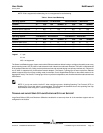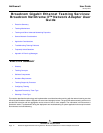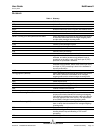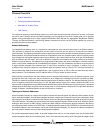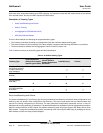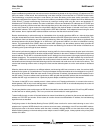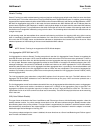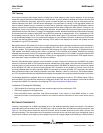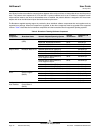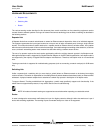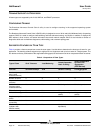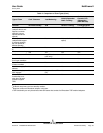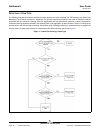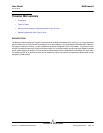
NetXtreme II User Guide
January 2010
Broadcom Corporation
Page 20 Executive Summary Document ENGSRVT52-CDUM100-R
Generic Trunking
Generic Trunking is a switch-assisted teaming mode and requires configuring ports at both ends of the link: server interfaces
and switch ports. This is often referred to as Cisco Fast EtherChannel or Gigabit EtherChannel. In addition, generic trunking
supports similar implementations by other switch OEMs such as Extreme Networks Load Sharing and Bay Networks or IEEE
802.3ad Link Aggregation static mode. In this mode, the team advertises one MAC Address and one IP Address when the
protocol stack responds to ARP Requests. In addition, each physical adapter in the team uses the same team MAC address
when transmitting frames. This is possible since the switch at the other end of the link is aware of the teaming mode and will
handle the use of a single MAC address by every port in the team. The forwarding table in the switch will reflect the trunk as
a single virtual port.
In this teaming mode, the intermediate driver controls load balancing and failover for outgoing traffic only, while incoming
traffic is controlled by the switch firmware and hardware. As is the case for Smart Load Balancing, the BASP intermediate
driver uses the IP/TCP/UDP source and destination addresses to load balance the transmit traffic from the server. Most
switches implement an XOR hashing of the source and destination MAC address.
NOTE: Generic Trunking is not supported on iSCSI offload adapters.
Link Aggregation (IEEE 802.3ad LACP)
Link Aggregation is similar to Generic Trunking except that it uses the Link Aggregation Control Protocol to negotiate the
ports that will make up the team. LACP must be enabled at both ends of the link for the team to be operational. If LACP is
not available at both ends of the link, 802.3ad provides a manual aggregation that only requires both ends of the link to be
in a link up state. Because manual aggregation provides for the activation of a member link without performing the LACP
message exchanges, it should not be considered as reliable and robust as an LACP negotiated link. LACP automatically
determines which member links can be aggregated and then aggregates them. It provides for the controlled addition and
removal of physical links for the link aggregation so that no frames are lost or duplicated. The removal of aggregate link
members is provided by the marker protocol that can be optionally enabled for Link Aggregation Control Protocol (LACP)
enabled aggregate links.
The Link Aggregation group advertises a single MAC address for all the ports in the trunk. The MAC address of the
Aggregator can be the MAC addresses of one of the MACs that make up the group. LACP and marker protocols use a
multicast destination address.
The Link Aggregation control function determines which links may be aggregated and then binds the ports to an Aggregator
function in the system and monitors conditions to determine if a change in the aggregation group is required. Link
aggregation combines the individual capacity of multiple links to form a high performance virtual link. The failure or
replacement of a link in an LACP trunk will not cause loss of connectivity. The traffic will simply be failed over to the remaining
links in the trunk.
SLB (Auto-Fallback Disable)
This type of team is identical to the Smart Load Balance and Failover type of team, with the following exception—when the
standby member is active, if a primary member comes back on line, the team continues using the standby member rather
than switching back to the primary member. This type of team is supported only for situations in which the network cable is
disconnected and reconnected to the network adapter. It is not supported for situations in which the adapter is removed/
installed through Device Manager or Hot-Plug PCI.
If any primary adapter assigned to a team is disabled, the team functions as a Smart Load Balancing and Failover type of
team in which auto-fallback occurs.




